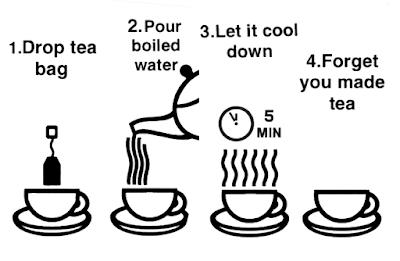Learn how to Make Tea
Whenever somebody tells me they really don't like the flavor
of tea, I always believe they've simply never drank a properly prepared cup.
The reason many men and women haven't had the pleasure of drinking
well-prepared tea is simple to comprehend, considering the large difference in
the process of brewing for various types of tea. And when you make an important
error, you'll be left with a disgusting cup of tea. The good news is that you
can essentially use almost any method for pretty much any kind of tea. Being
aware of a couple of important factors is really all you need to do and I'll
show you those below.
Let's start with the easiest one. Black tea is by far the
simplest to make and not many persons have any significant difficulties making
a great cup. Basically, you dump 100 ºC water on top of the leaves and let them
steep for 2-3 minutes. This technique will be successful for Assam tea and all
of the widely consumed Chinese teas, Ceylon teas or Nepalese teas. Darjeeling
tea must not be made in this way, however. It should be made with colder water
(80-90ºC or 180-194ºF), since it is not completely oxidized and essentially
like an oolong tea.
Green teas are generally slightly more tasking to brew
properly and you'll encounter a sizable variety in preparation methods between
the various types. The proper water temperature and the steeping times are the
two factors you really must take care to get right. The majority of green teas
are ideally brewed using a temperature of around 80°C (176°F).
Be sure to use a significantly cooler 50°C-60°C
(122°F-140°F) for the top quality Japanese tea gyokuro, however. An additional
exception is Houjicha, a roasted Japanese tea. Perhaps the most difficult tea
to get wrong, it can simply be brewed using 100°C water. The suggestions
written on the package will indicate a good point to start for steeping times.
In the absence of instructions, try two minutes for most teas and a minute and
a half for gyokuro.
There is one green tea that is entirely unlike all the
others and that can't be brewed with the guidelines I gave above: Matcha green
tea powder. As you might guess from the name, it comes in powder form and as
such, it calls for unique implements and a very distinctive and fairly complex
method of preparation. If you have ever seen a Japanese tea ceremony, you've
witnessed the making of matcha. I would prefer not to go off on a tangent of
several thousand words, so I'll leave off diving into specifics on the way of
preparation for this exceptional quality tea.
White tea can be a little more tasking to brew well, too. It
needs a much lower water temperature than green tea, because the leaves are
much more delicate. 75-80°C (167-176°F) is appropriate for both White Hair
Silver Needle and White Peony teas. In terms of steeping times, begin with 2-3
minutes and fine tune it from there. To make your tea stronger, bump up the
steeping time; to make it less astringent, subtract from it.
Oolong teas are probably the most tasking variety to brew
the correct way, excepting matcha. Usually, they are prepared using a huge
amount of leaves and very quick steeping times over many infusions. A standard
method of preparation will result in great cup, though. Just make sure the
water temperature is just a little below 100°C and you'll be fine.
I realize the instructions I've detailed above are quite
simplistic. Of course, using the specific instructions for each specific tea
will give you the tastiest cup. If you don't have those, however, following my
guidelines will get you a great cup of tea, no matter the variety. Ideally,
this should inspire at least a couple of folks who have previously made up
their mind that they hate the taste of tea, to give it a second chance. You
will not regret it.



Nice Article
ReplyDelete